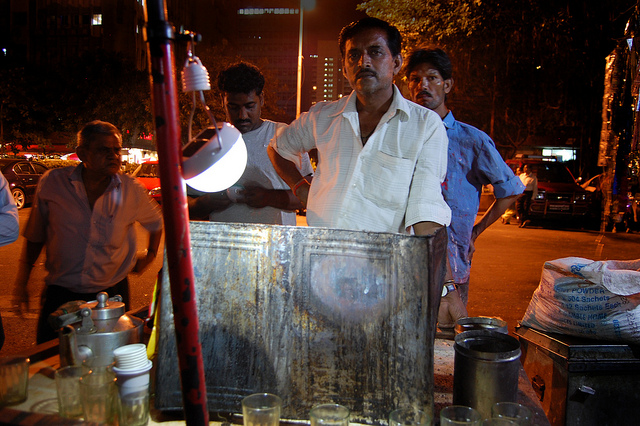Podcast: Play in new window | Download
Subscribe: RSS

A Mumbai vendor uses a lamp, charged during the day by the solar panel he is holding, to bring business to his stall. Such affordable solar solutions are helping people all over the country deal with an unreliable (and seemingly unfixable) grid. (Photo by Nokero/Flickr)
A tiny village in India offers a lesson to the world: in a country reeling from failures of its grid, shortages of fuel for power generation, daily blackouts and brownouts, the village has power for lights, water pumps, fans, battery-chargers and the like all the time, from an inexhaustible source. Note to anyone interested in surviving the coming crash of the industrial age: listen up.
When Meerwada was connected to the grid, life, work and study came to a virtual halt at sundown. Now, Meerwada has night life, thanks to a 14kw array of solar panels. The Meerwada system is not the solution, rather it points the way to the solution. The village could never have afforded the initial expense of over $100,000 for a system covering the needs of its 400 people. It was installed as a demonstration project by SunEdison of California, which believes that the dropping prices of solar panels, inverters and related hardware will make such projects economically viable within a few years.
Meanwhile, a village that lowers its expectations just a little can have its own array today, and they are bup and running all over the country. A private company, Mera Gao Power, for example, builds DC systems to provide basic power needs to 100 houses for $2,500, then charges about $2 per month per house. That means the company recovers its investment in about one year. If the cost of building or rebuilding the grid or any portion of it could be reimbursed by the ratepayers in a year, we would not have a problem.
Moreover, the Indian government will pay 30 per cent of the installation cost, and/or offer low-cost loans for the project. Many solar companies are providing the down payments, or guaranteeing loans.
The problem is, of course, that every industrialist who sees these examples of small-scale success sees the future in terms of bigger, better, a search for economies of scale from bigger arrays, larger grids, huge battery banks. This simply leads us back to there we are.
Instead, why not face the other way — smaller, better, with each house or small group of houses, and each business generating the electricity it needs, with running water if they have it, wind if they can get it, or the sun. Never mind whether the whole country can be converted in a week, or whether it takes more than 120 days to recover the investment. The point is that the folks who do this now will have electricity when the grid goes down and stays down. And that, as the credit-card ad used to say, is priceless.
Nothing can save us all from the collapse of industry. It follows that rejecting solutions that don’t save everybody means rejecting all possible solutions and experiencing paralysis. When it comes to electricity, here is something that can save anyone who finds a way to do it, while those who rely on industry to come through will be left in the deep dark.
[Off Grid Power Shines in India Solar Village — Reuters]